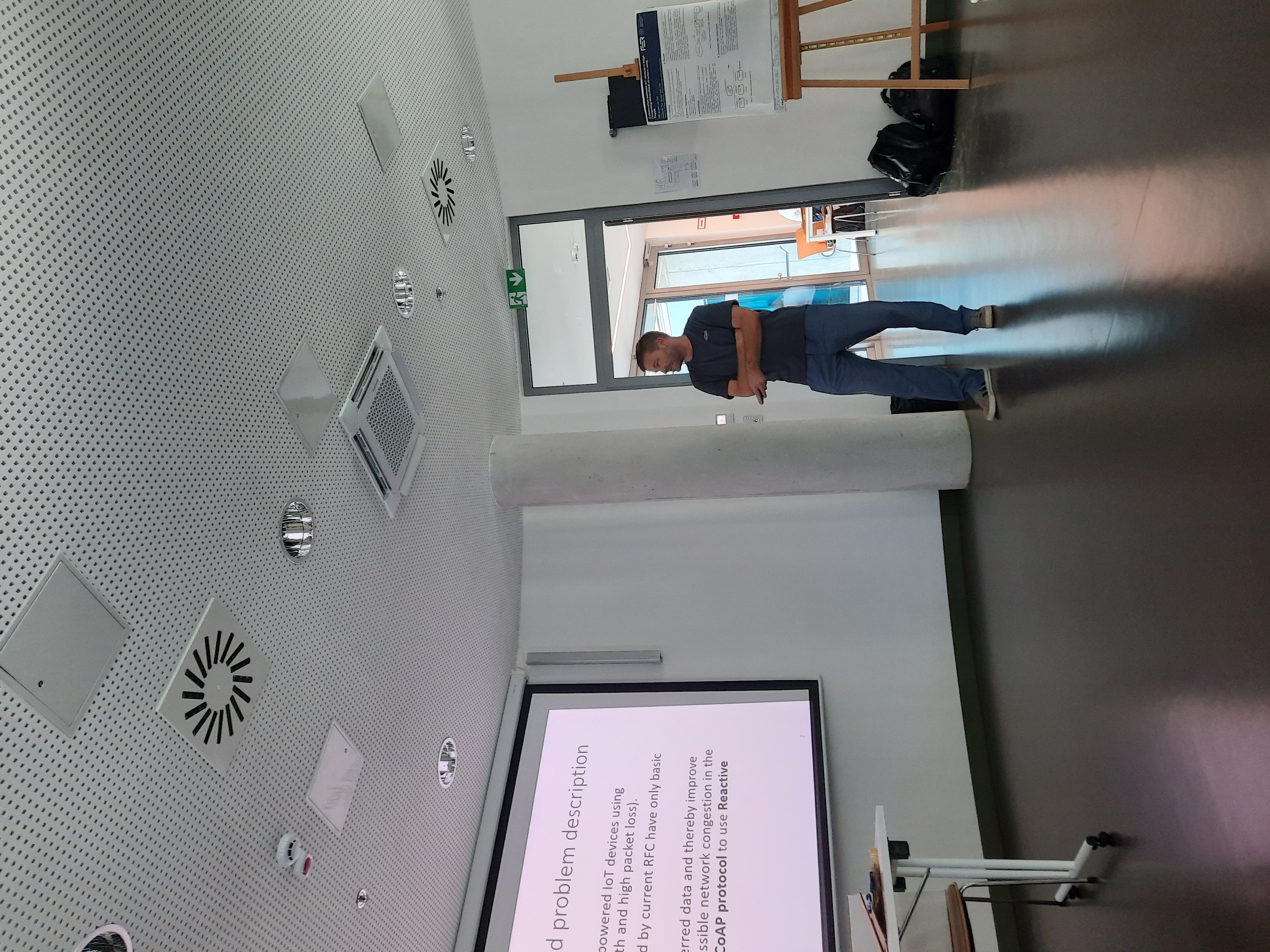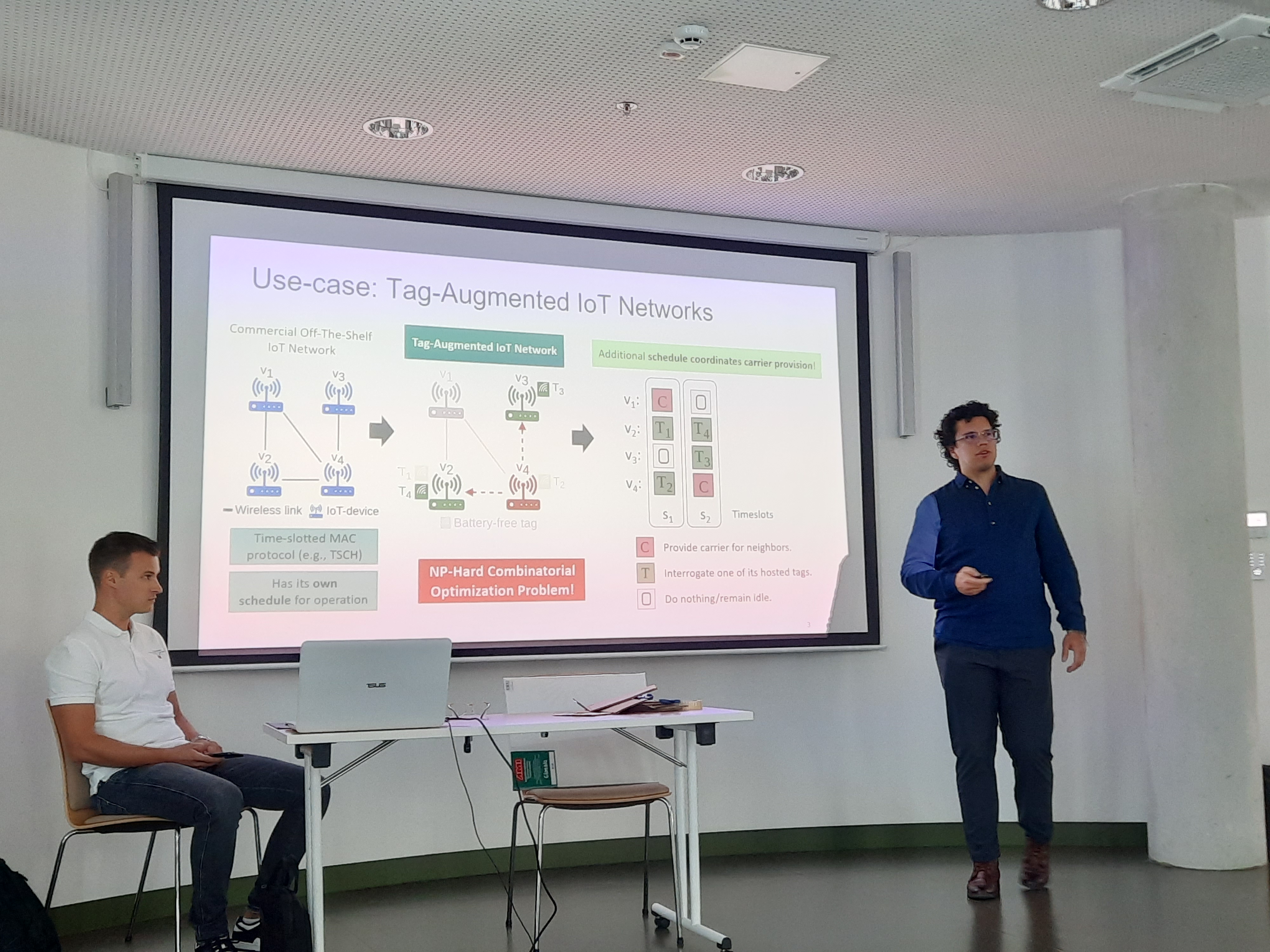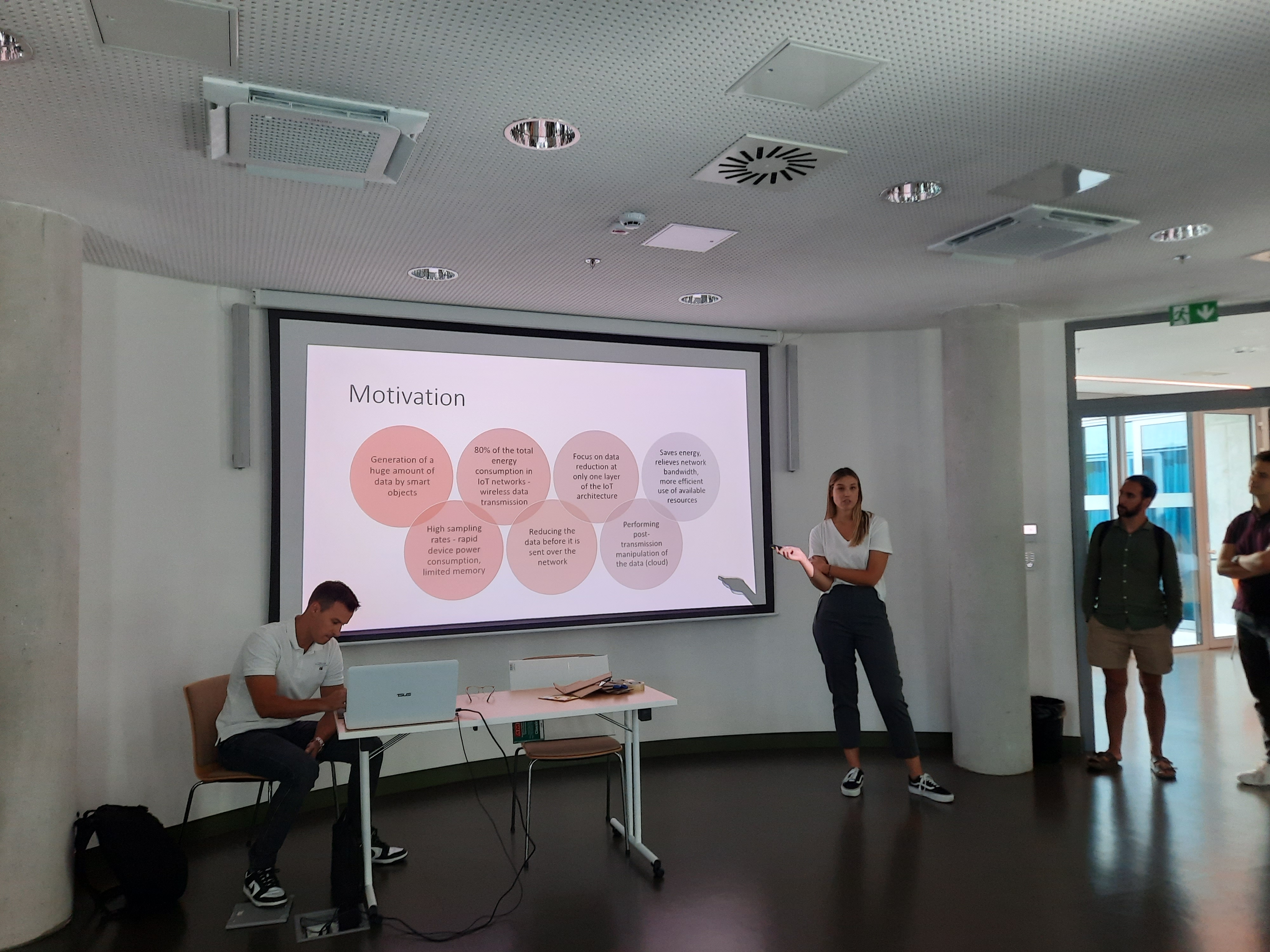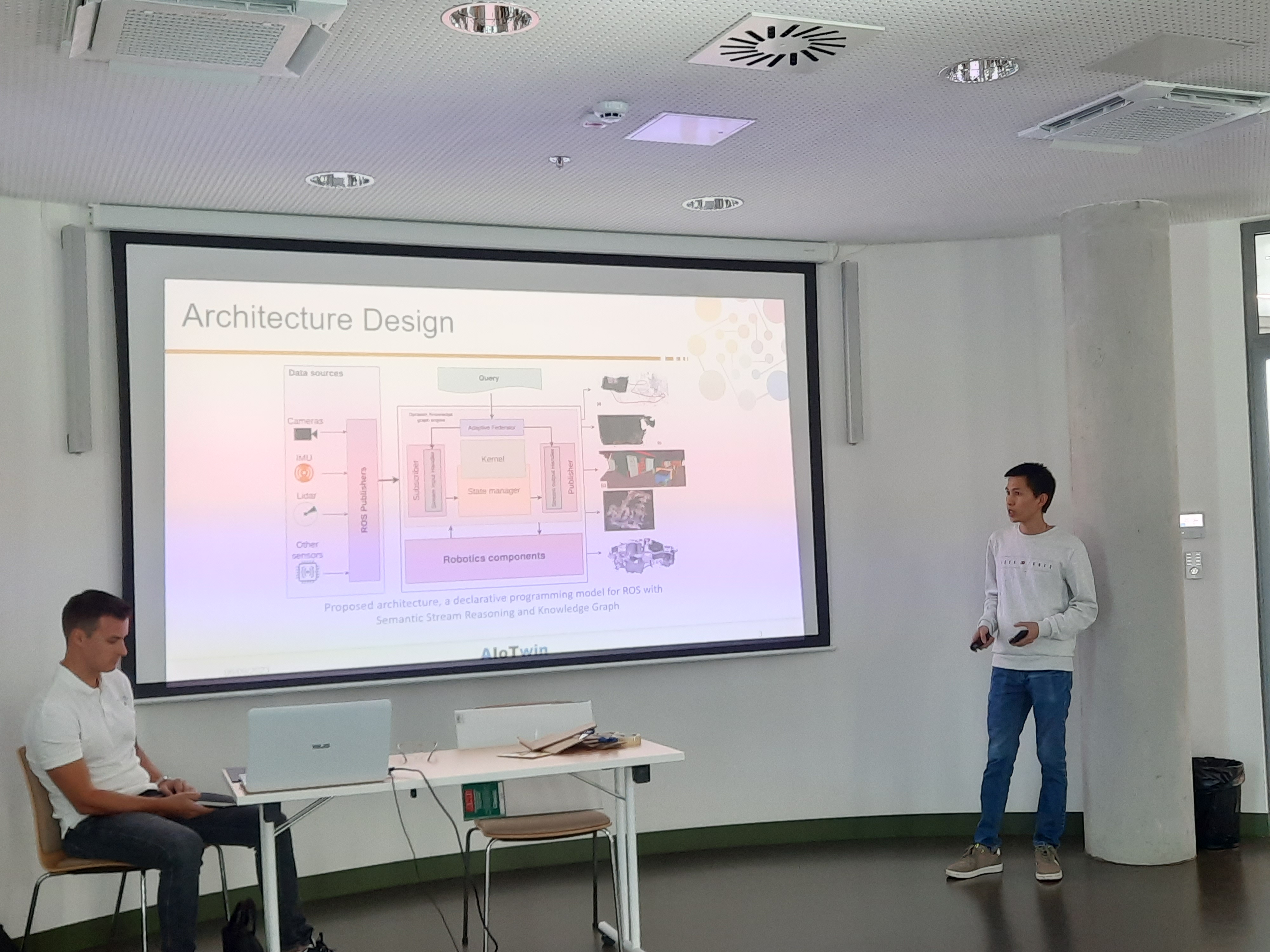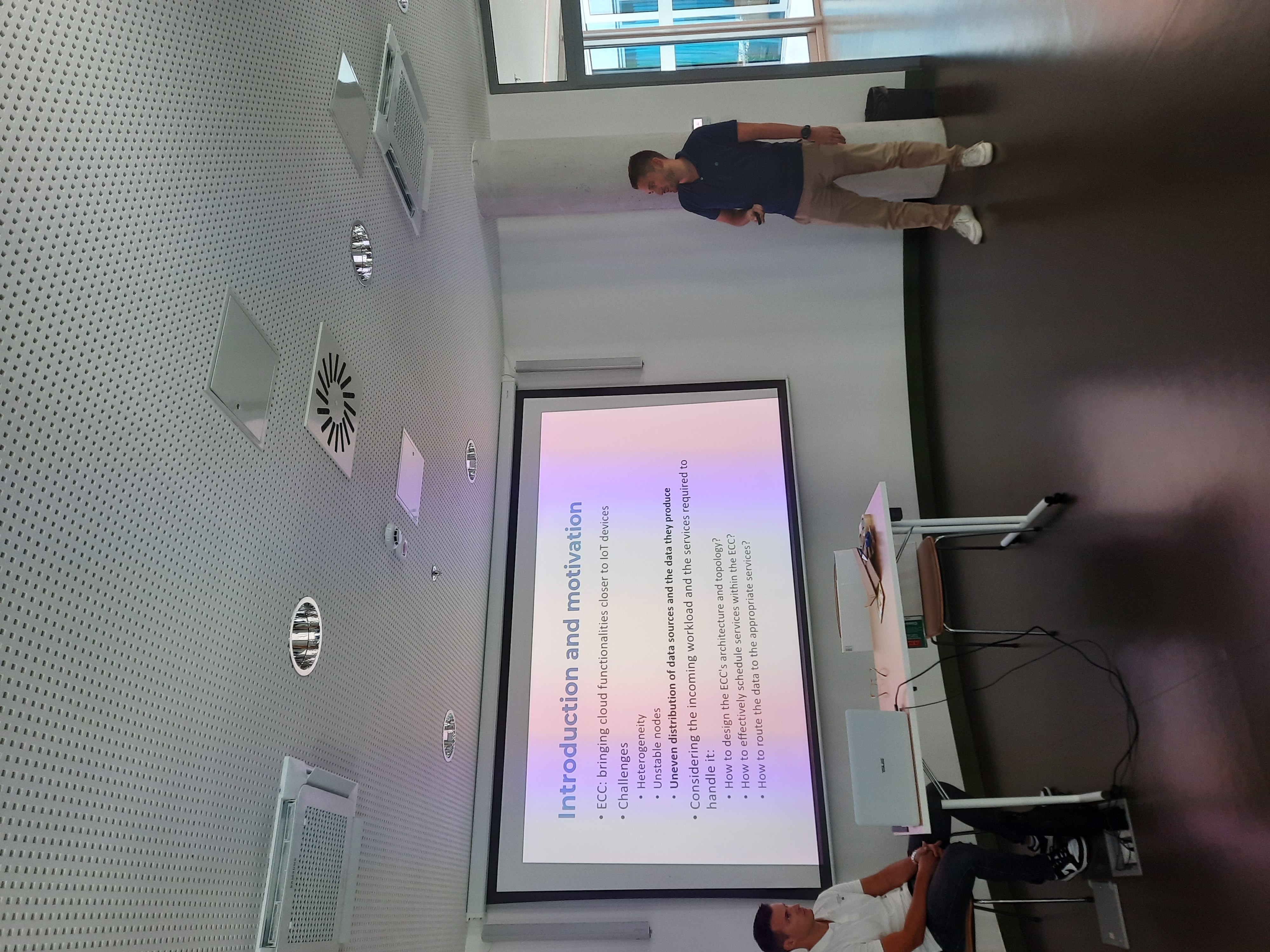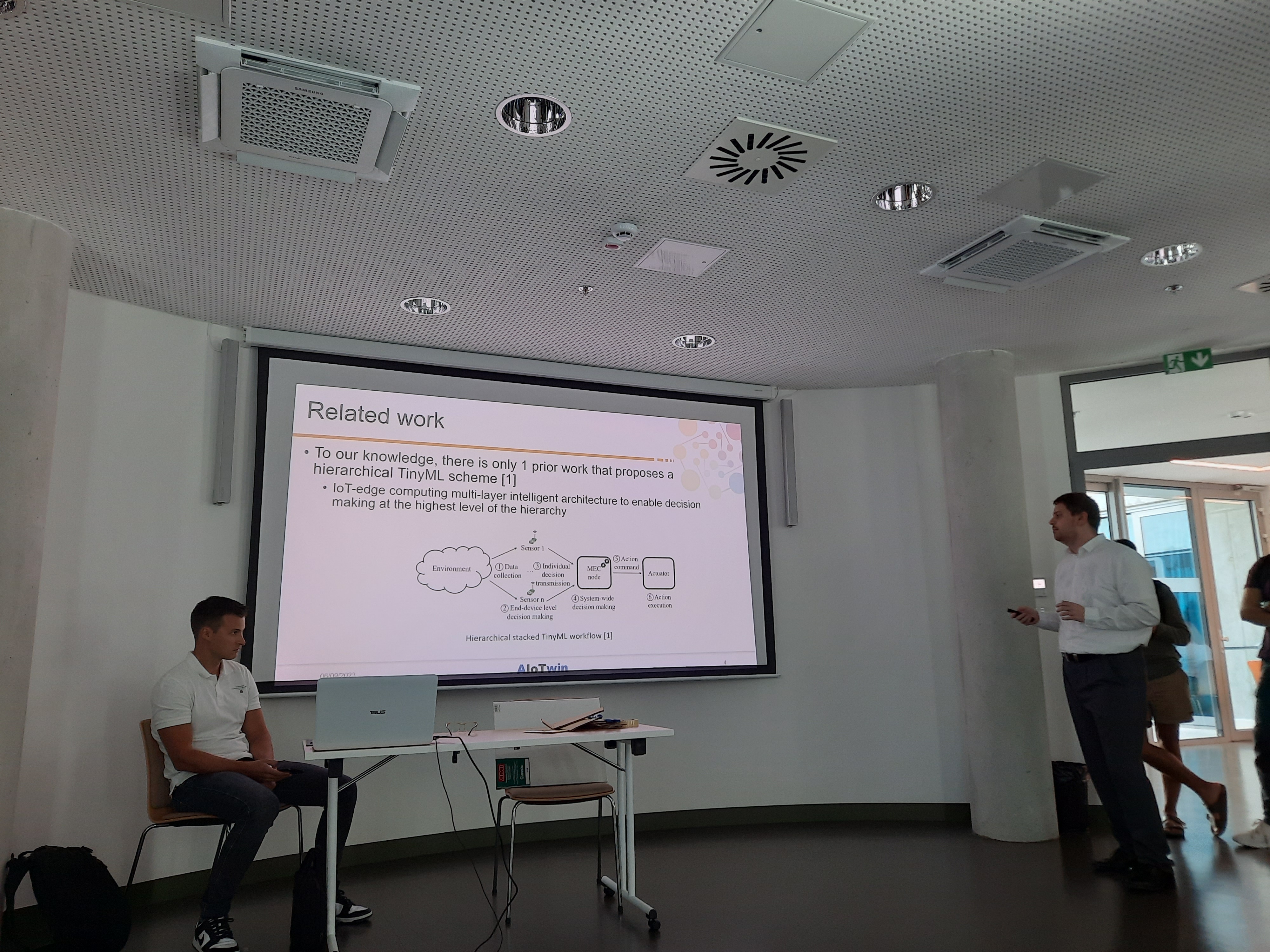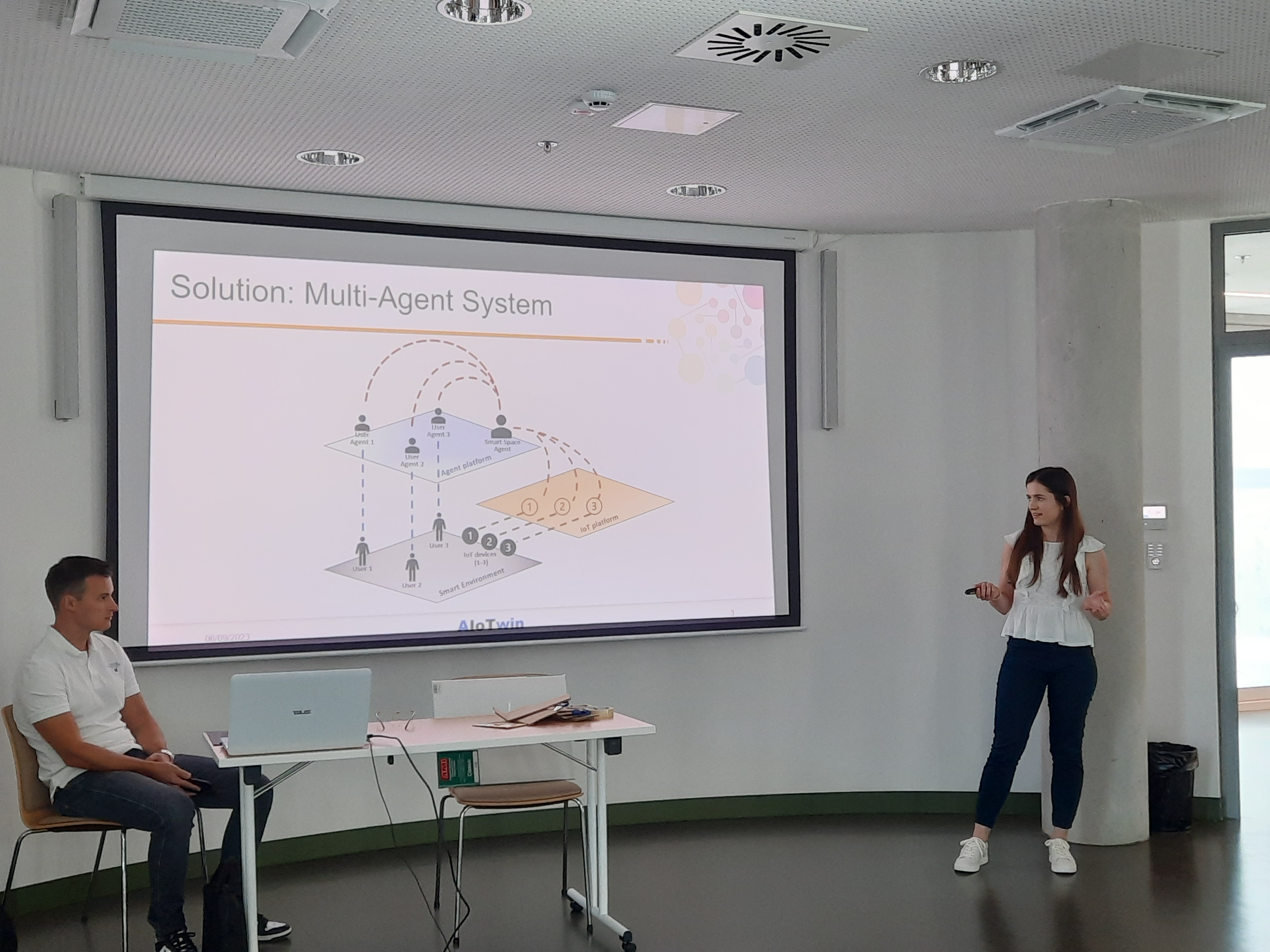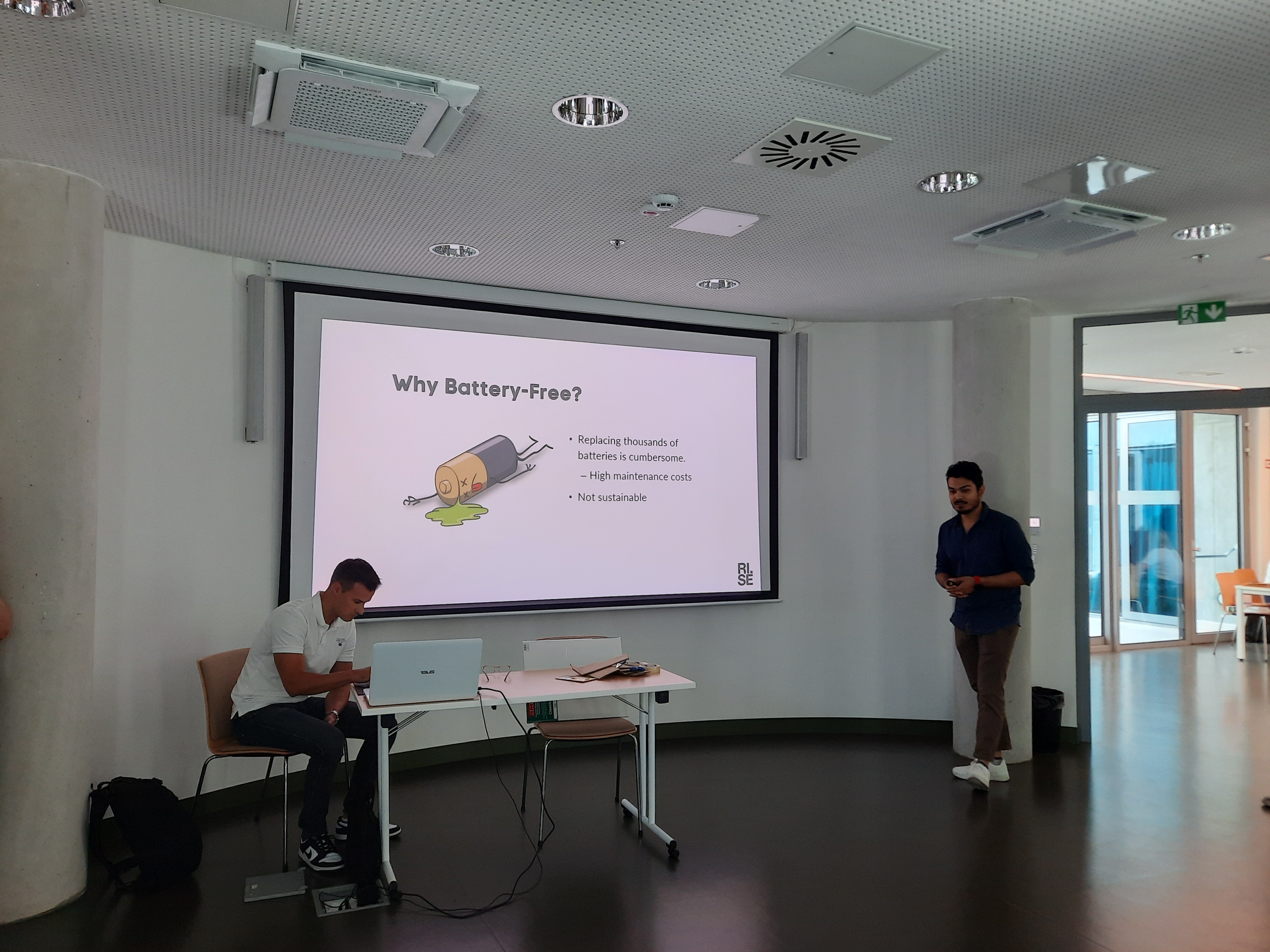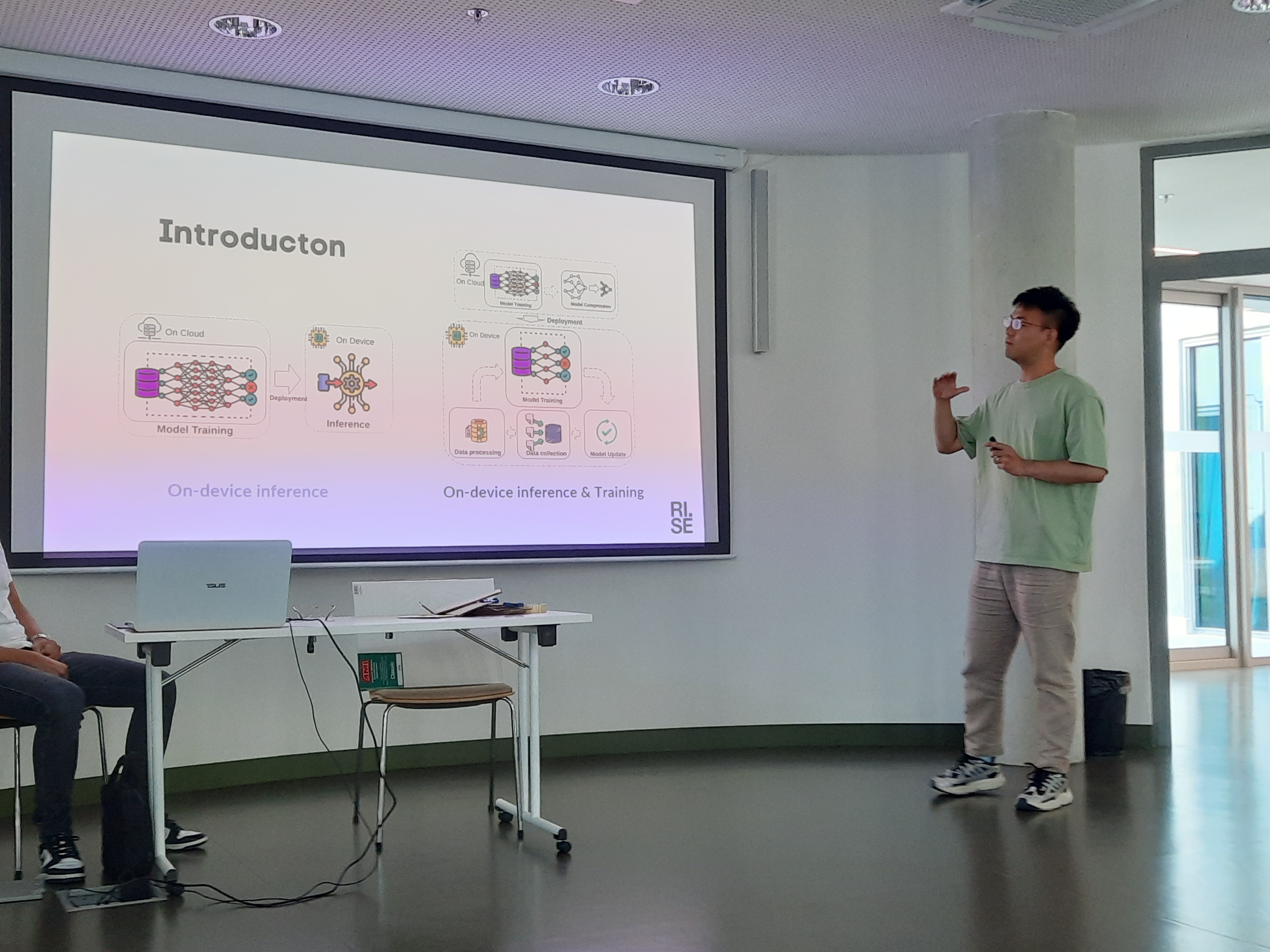The first PhD forum within the scope of the AIoTwin project was held as a part of the 1st AIoTwin Summer School in Šibenik from September 4th to September 7th, 2023. Eleven PhD students actively participated and presented their research topics and the results obtained within their doctoral studies through the short pitch-talk presentations. Afterwards, the participants had the opportunity to discuss their research ideas and contributions with other participants and senior researchers from the AIoTwin consortium at the poster session. In continuation you can find abstracts of each presented paper, while in repository extended abstracts are available for download.
Dalibor Fonović: "Using reactive paradigm with COAP protocol"
The Constrained Application Protocol (COAP) is a lightweight communication protocol designed for efficient data exchange in resource-constrained environments and intended for use in IoT applications. However, the functionality of the COAP protocol is limited. By incorporating reactive program- ming concepts into COAP, its ability to manage dynamic and asynchronous communication can be improved to better meet the needs of modern IoT applications. The goal of this research is to investigate the integration of the reactive paradigm with the COAP protocol, which will be used in the dissertation as a mechanism to improve energy efficiency and reduce network congestion.
Daniel Perez: "Machine Learning for Combinatorial Resource Allocation"
This project investigates the potential of machine learning methods for optimizing resource allocation problems of combinatorial nature in large, heterogeneous networked systems. Traditional heuristic algorithms, while computationally less in- tensive, often result in sub-optimal solutions that lead to resource wastage and increased energy consumption. As a milestone in the project we introduce DeepGANTT, a novel learning-based sched- uler that leverages Graph Neural Networks and Transformers to solve an NP-hard combinatorial resource allocation problem for IoT networks with battery-free sensor tags. DeepGANTT offers up to 50% reduction in resource consumption compared to the state-of-the-art heuristic, and is capable of scaling to networks significantly larger than those used for training without the need to be retrained. The scheduler is designed for generalizability and elasticity, adapting to varied network sizes and conditions while maintaining efficient runtimes. Our findings pave the way for future research in applying machine learning techniques to enhance resource allocation in diverse networked systems.
Dora Kreković: "Optimizing Data Transfer in IoT: Strategies for Reducing Data Volume"
The rapid proliferation of Internet of Things (IoT) devices has led to a significant increase in data generation and transmission. However, the limitations of IoT devices, including constrained processing power, memory, and battery capacity, along with restricted network technologies, necessitate effective data management. This study offers an overview of various techniques proposed to reduce the volume of data transferred within IoT contexts. These techniques encompass approaches like data compression, aggregation, and selective transmission. By exploring the advantages, constraints, and suitable deployment contexts of these methods, this research aims to contribute to the evolving field of data reduction in the IoT environment. This contribution aims to improve network efficiency, reduce energy consumption, and optimize data usage, thereby enhancing the overall landscape of data management in the IoT domain.
Duc Manh Nguyen: "Cooperative Sensing with Semantic Stream Processing"
This thesis is motivated by the challenge of effectively uti- lizing real-time sensor data in the IoT. The imbalance between vast data volumes and users’ time-sensitive needs necessitates a shift from simplistic cloud-based approaches. The rise of IoT expose this issue, prompting the exploration of Fog/Edge Computing paradigms. This thesis seeks to leverage semantic technologies to enable autonomous, cooperative sensing at network edges, enhancing data discovery and exchange amidst sensor data heterogeneity. The fusion of Fog/Edge computing and semantics holds the promise of optimizing information processing in dynamic sensor environments.
Ivan Čilić: "Runtime Model for Distributed Workload in the Edge-to-Cloud Continuum"
Edge-to-Cloud Continuum (ECC) optimizes IoT data processing by executing it closer to the data sources. The hierarchical structure of ECC spans from resource-constrained IoT devices to high-performance cloud servers, providing a distributed IoT environment with lower network congestion, improved response times and enhanced security compared to cloud-based IoT solutions. Despite its advantages, ECC faces challenges due to its heterogeneous and dynamic nature that has to deal with uneven distribution of data sources. To address these challenges, in this doctoral research, we propose a runtime model for distributed workload in ECC. The model describes the behavior of data sources in ECC, the services required to process the generated data, and the underlying topology of ECC that hosts these services. This model serves as the basis for the implementation of the ECC workload simulator which provides insight into the data dynamics within the edge computing nodes and the ability of the processing services to handle the incoming workload. By simulating the workload and processing in a distributed ECC environment, the simulator can help optimize topology design, service scheduling, and data routing decisions.
Ivan Kralj: "Collaboration between IoT-devices in Edge Computing hierarchical structure using TinyML"
The coordinated integration of heterogeneous TinyML-enabled elements in highly distributed Internet of Things (IoT) environments paves the way for the development of truly intelligent and context-aware applications. Edge computing has emerged during the last years as a ground-breaking solution that permits to enrich regular IoT deployments with novel ser- vices and possibilities. Under this paradigm, the processing and storage capabilities of end-devices and edge-nodes are exploited in order to reduce their cloud-dependency by adding a new layer in the network architecture in charge of data aggregation, filtering, processing, and storage. On the other hand, TinyML is a recently-emerged paradigm that proposes to embed optimized Machine Learning (ML) models in units with limited computing resources, such as those powered by micro-controllers. Our goal in this doctoral research is to optimize traffic control systems through the integration of IoT-devices within an Edge Computing hierarchical structure. Specifically, the focus is on leveraging TinyML techniques in the context of IoT for traffic control applications.
Katarina Mandarić: "Negotiation-Enabled Multi-Agent System for Service Provisioning in Multi-User Scenarios"
Smart Homes and Environments have been the focus of research for many decades. From connecting devices, to simple automation rules, now Smart Homes are on another level. By introducing cognitive capabilities with Internet of Things, it has become possible to create truly smart systems which offer services that cater to the wishes and needs of users. Researchers proposed very advanced Smart Home systems over the years, but mostly focus on single user scenarios. Scenarios involving multiple users with individual needs and desires that are often opposed to each other are largely neglected. In this paper, we discuss the possibility of the application of software agents, i.e. a multi- agent system in which users are represented by user agents who, knowing the preferences of their users, negotiate with each other to reach a joint decision that best satisfies all users.
Marko Križmančić: "Distributed topology control in networked multi-agent systems based on consensus protocol and graph neural networks"
This research aims to develop a distributed, adap- tive, and scalable method for controlling communication topology in networked multi-agent systems. The method uses algebraic connectivity tracking and resilience optimization, using a con- sensus protocol for estimating the global topology through local communication. Agents converge to a common state and collec- tively select the best link(s) to add or remove using a heuristic or novel graph neural network (GNN) method. Additionally, a new GNN model will enhance system resilience without compromising desired connectivity.
Saptarshi Hazra: "Data-Driven Approaches for Battery-Free IoT Networks"
The constant requirement for battery replacements is a significant barrier in the world of the Internet of Things (IoT), with concerns about battery sustainability and effective recycling. These critical challenges motivate the need for the growth of battery-free IoT, in which devices use ambient energy from sources such as photovoltaic or piezoelectric harvesters. However, due to the unpredictable and sporadic availability of ambient energy, there are obstacles in the design and implementation of such devices. The unpredictability of ambient energy emphasizes the requirement for methods that allow for frequent communication with efficient data transmission. Furthermore, because these devices have limited processing capabilities and must balance energy usage for computation with communication, securing them is partic- ularly difficult. In this abstract, we present three pertinent challenges and our data-driven approaches to these challenges.
Shuai Zhu: "On-device Learning for Secure Internet of Things"
The recent breakthroughs in machine learning (ML) and deep learning (DL) have catalyzed the design and de- velopment of various intelligent systems over wide application domains. While most existing machine learning models require large memory and computing power, ML/DL applications on edge devices have been extensively studied in recent years. Most early systems exploit the inference capabilities of ML and DL models that are already trained on data captured from different mobile and embedded sensing components for specific application goals, such as classification and segmentation. More recently, on-device learning (ODL) has gained attention, which refers to using resource-constrained devices, such as mobile phones and embedded systems, for ML/DL model training. The reason is that ODL makes ML-based systems smarter and more robust, for example, ODL can help to cope with data drift problems by tuning deployed models according to deployed environments on the fly. However, most state-of-the-art ODL systems are designed for less resource-constrained devices, such as smartphones. This research project aims to enable ODL on devices with extremely limited hardware resources, for example, low-power IoT devices. A potential use case is to apply ODL to IoT security, for instance, jamming attack detection and classification for low- power wireless networks.
Jicheng Yuan: "VisionKG: Unified Access for Integrated Visual Datasets"
Large-scale datasets play a key role in the success of modern computer vision. However, most are narrowly tailored for specific tasks, with restricted image data distributions. There is no unified approach to organizing and accessing them across diverse sources, tasks, and taxonomies. Hence, models can only perform well in specific domains. This not only creates unnecessary over- heads when building robust visual recognition systems but also introduces biases into learning systems and limits the capabilities of data-centric AI. Addressing these problems, Vision Knowledge Graph (VisionKG) is a novel framework that interlinks and organizes visual datasets via knowledge graphs. As real-world scenarios encompass diverse weather conditions and imbalanced class distributions, we will introduce a semi-supervised domain adaptive object detection architecture empowered by VisionKG to navigate these challenges. Additionally, drawing on data enriched with semantically rich descriptions in VisionKG, we will evaluate VisionKG’s efficacy in boosting transparency, ensuring traceability of data sources, and fostering trust in AI systems.

